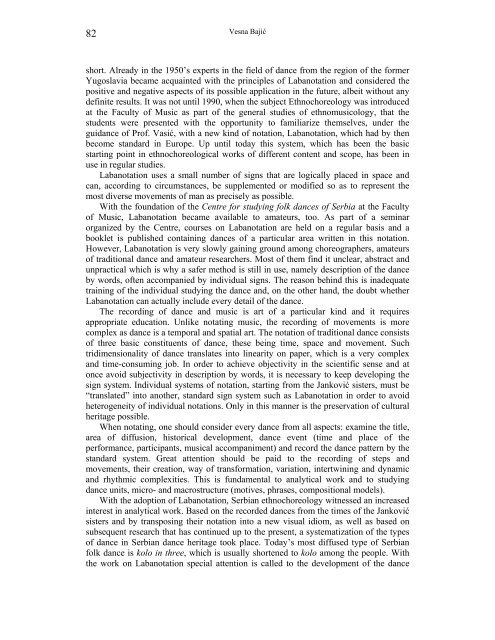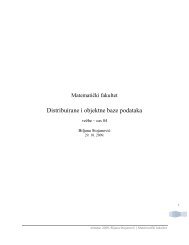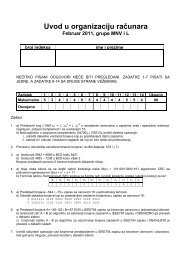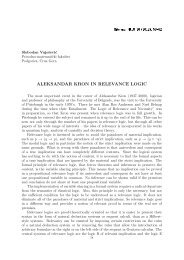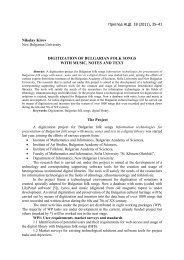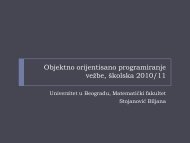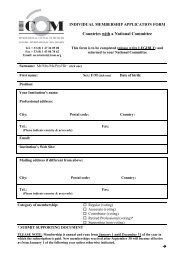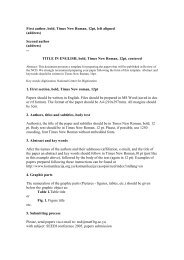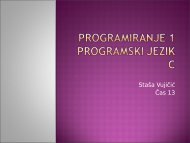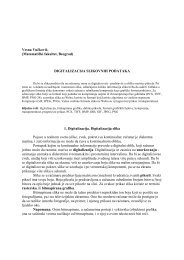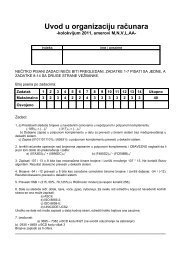Vesna BajiÄ (Faculty of Music, Belgrade) THE ... - Ncd.matf.bg.ac.rs
Vesna BajiÄ (Faculty of Music, Belgrade) THE ... - Ncd.matf.bg.ac.rs
Vesna BajiÄ (Faculty of Music, Belgrade) THE ... - Ncd.matf.bg.ac.rs
You also want an ePaper? Increase the reach of your titles
YUMPU automatically turns print PDFs into web optimized ePapers that Google loves.
82<strong>Vesna</strong> Bajićshort. Already in the 1950’s experts in the field <strong>of</strong> dance from the region <strong>of</strong> the formerYugoslavia became <strong>ac</strong>quainted with the principles <strong>of</strong> Labanotation and considered thepositive and negative aspects <strong>of</strong> its possible application in the future, albeit without anydefinite results. It was not until 1990, when the subject Ethnochoreology was introducedat the <strong>F<strong>ac</strong>ulty</strong> <strong>of</strong> <strong>Music</strong> as part <strong>of</strong> the general studies <strong>of</strong> ethnomusicology, that thestudents were presented with the opportunity to familiarize themselves, under theguidance <strong>of</strong> Pr<strong>of</strong>. Vasić, with a new kind <strong>of</strong> notation, Labanotation, which had by thenbecome standard in Europe. Up until today this system, which has been the basicstarting point in ethnochoreological works <strong>of</strong> different content and scope, has been inuse in regular studies.Labanotation uses a small number <strong>of</strong> signs that are logically pl<strong>ac</strong>ed in sp<strong>ac</strong>e andcan, <strong>ac</strong>cording to circumstances, be supplemented or modified so as to represent themost dive<strong>rs</strong>e movements <strong>of</strong> man as precisely as possible.With the foundation <strong>of</strong> the Centre for studying folk dances <strong>of</strong> Serbia at the <strong>F<strong>ac</strong>ulty</strong><strong>of</strong> <strong>Music</strong>, Labanotation became available to amateu<strong>rs</strong>, too. As part <strong>of</strong> a seminarorganized by the Centre, cou<strong>rs</strong>es on Labanotation are held on a regular basis and abooklet is published containing dances <strong>of</strong> a particular area written in this notation.However, Labanotation is very slowly gaining ground among choreographe<strong>rs</strong>, amateu<strong>rs</strong><strong>of</strong> traditional dance and amateur researche<strong>rs</strong>. Most <strong>of</strong> them find it unclear, abstr<strong>ac</strong>t andunpr<strong>ac</strong>tical which is why a safer method is still in use, namely description <strong>of</strong> the danceby words, <strong>of</strong>ten <strong>ac</strong>companied by individual signs. The reason behind this is inadequatetraining <strong>of</strong> the individual studying the dance and, on the other hand, the doubt whetherLabanotation can <strong>ac</strong>tually include every detail <strong>of</strong> the dance.The recording <strong>of</strong> dance and music is art <strong>of</strong> a particular kind and it requiresappropriate education. Unlike notating music, the recording <strong>of</strong> movements is morecomplex as dance is a temporal and spatial art. The notation <strong>of</strong> traditional dance consists<strong>of</strong> three basic constituents <strong>of</strong> dance, these being time, sp<strong>ac</strong>e and movement. Suchtridimensionality <strong>of</strong> dance translates into linearity on paper, which is a very complexand time-consuming job. In order to <strong>ac</strong>hieve objectivity in the scientific sense and atonce avoid subjectivity in description by words, it is necessary to keep developing thesign system. Individual systems <strong>of</strong> notation, starting from the Janković siste<strong>rs</strong>, must be“translated” into another, standard sign system such as Labanotation in order to avoidheterogeneity <strong>of</strong> individual notations. Only in this manner is the preservation <strong>of</strong> culturalheritage possible.When notating, one should consider every dance from all aspects: examine the title,area <strong>of</strong> diffusion, historical development, dance event (time and pl<strong>ac</strong>e <strong>of</strong> theperformance, participants, musical <strong>ac</strong>companiment) and record the dance pattern by thestandard system. Great attention should be paid to the recording <strong>of</strong> steps andmovements, their creation, way <strong>of</strong> transformation, variation, intertwining and dynamicand rhythmic complexities. This is fundamental to analytical work and to studyingdance units, micro- and m<strong>ac</strong>rostructure (motives, phrases, compositional models).With the adoption <strong>of</strong> Labanotation, Serbian ethnochoreology witnessed an increasedinterest in analytical work. Based on the recorded dances from the times <strong>of</strong> the Jankovićsiste<strong>rs</strong> and by transposing their notation into a new visual idiom, as well as based onsubsequent research that has continued up to the present, a systematization <strong>of</strong> the types<strong>of</strong> dance in Serbian dance heritage took pl<strong>ac</strong>e. Today’s most diffused type <strong>of</strong> Serbianfolk dance is kolo in three, which is usually shortened to kolo among the people. Withthe work on Labanotation special attention is called to the development <strong>of</strong> the dance


